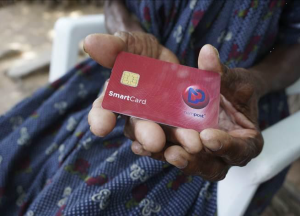April 2014
“I the God of Israel will not forsake them. I will open rivers on the bare heights,and fountains in the midst of the valleys; I will make the wilderness a pool of water and the dry land springs of water.”
Isaiah 41:17b-18
Water is a gift from God that is both essential to life and to our spiritual life as Christians. Water quenches our thirst, serves as a symbol of the beginning of our journey as Christians and nourishes and renews all life on earth. Stewardship of water resources is a critical part of our call to care for God’s creation.
The Clean Water Act
The Clean Water Act, which passed Congress in 1973, requires the federal government to protect the waters of the United States from pollution. Passed at a time in our national history when some rivers were so contaminated with industrial waste they could catch on fire, this landmark legislation is the reason that our lakes, rivers and streams can serve our communities as drinking water sources, support commercial and recreational fishing, and provide opportunities for swimming and other recreation. But many of our bodies of water are still under threat from pollution, and in recent years the scope of the Clean Water Act was called into question by two Supreme Court cases. These cases created uncertainty about whether small wetlands and streams are “waters of the United States” and deserving of the full protection of clean water regulations.
For more than four decades, the Clean Water Act protected the smaller streams and wetlands that feed into larger watersheds in our interconnected system of waters. According to the U.S. Environmental Protection Agency, about 60 percent of stream miles in the U.S. only flow seasonally or after rain, but have a considerable impact on the downstream waters. In fact, according to the agency, one in three Americans — more than 117 million people — get their drinking water from sources fed by these small and seasonal streams. But determining Clean Water Act protection for small streams and wetlands became confusing and complex following Supreme Court decisions in 2001 and 2006 that required the EPA to consider impacts on small and seasonal streams and wetlands on a case-by-case basis.
This month, the Environmental Protection Agency issued a draft rule that would provide clarity, protecting streams and wetlands that connect to larger watersheds and protecting the quality of the water that we depend on for drinking, washing, swimming and fishing. Under the proposed rule many of the streams and wetlands that were historically covered under the Clean Water Act will again be covered. The proposed rule works within the more narrow definition of “waters of the United States” given by the two Supreme Court rulings and clarifies that under the Clean Water Act:
- Most seasonal and rain-dependent streams are protected.
- Wetlands near rivers and streams are protected.
- Other types of waters that have more uncertain connections with downstream will be evaluated on a case-by-case basis to determine if their connection to overall water quality is significant. However, to provide more certainty, the proposal requests comment on options protecting similarly situated waters in certain geographic areas or adding to the categories of waters protected without case specific analysis.
In addition, the proposed rule preserves a number of exemptions to permit requirements for farming practices that have been developed over the 40-year history of the Clean Water Act to protect water quality.
Learn more
The EPA will be inviting the public to comment on the proposed rule over the coming months — if you’d like to learn more, go to the U.S. Environmental Protection Agency page on the proposed rule.
This year’s Earth Day Sunday resource celebrates God’s gift of water and includes materials for use in worship as well as educational materials — use “Water, Holy Water” to plan an Earth Day service or other event in your congregation.
From Evangelical Lutheran Worship (page 71):
Holy God, holy and merciful, holy and mighty, you are the river of life, you are the everlasting wellspring, you are the fire of rebirth. Glory to you for oceans and lakes, for rivers and streams. Honor to you for cloud and rain, for dew and snow. Your waters are below us, around us, above us: our life is born in you. You are the fountain of resurrection … Satisfy all our thirst with your living water, Jesus Christ, our Savior, who lives and reigns with you and the Holy Spirit, one God, now and forever. Amen.



 Namibia is facing one of the worst droughts it has seen in more than 25 years. According to a report from the United Nations, 778,504 people do not have food security, and 169,000 children are at risk of malnutrition.
Namibia is facing one of the worst droughts it has seen in more than 25 years. According to a report from the United Nations, 778,504 people do not have food security, and 169,000 children are at risk of malnutrition.